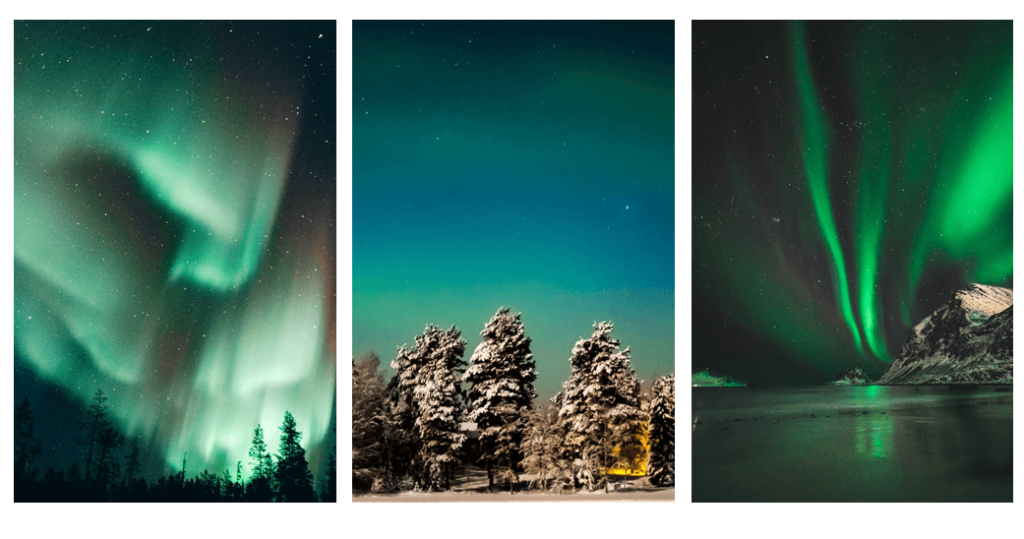
26 Feb Northern Lights: What, Why & Where
Picture this: its really cold, the clock is ticking towards midnight and with each passing second it gets even colder. Every breath comes out in a puff of smoke, and suddenly when the cold has just reached the peak you see the sky light up. Colors of green, pink, yellow and an occasional orange light up the sky. You have seen magic, perhaps the best show that nature puts out for you!
No matter how wonderful Northern Lights are and no matter how many times you see it on YouTube, to actually see it live takes a lot of effort and planning. So here is your guide to know everything you need to about the Northern Lights!
1. What are Northern Lights and what causes them?
The Northern Lights, scientifically known as Aurora Borealis, are a natural light display in the Earth’s sky. When the electrically charged particles from the sun collide with the gases from the Earth’s atmosphere, it causes displays of bright colourful lights in the sky!
Aurora displays appear in many colours; pale green and pink are the most common. Shades of red, yellow, green, blue, and violet have been reported. They will not always be extremely bright and loud, sometimes they might be just glimpses!

2. Where to see Northern Lights ?
A. The Northern Lights can be found in the “aurora zone” in the Northern Hemisphere. This is an area of 2,000-3,000km from the magnetic pole, or at a latitude of 66 to 69 degrees north. The closer you are to this region, the better your odds of catching the lights.
A. Scandinavia: It is perhaps one of the best places to spot Northern Lights. Another plus about travelling to Scandinavia is that you are just not going for the Northern Lights but for the destination itself. The prime pick of the lot is the Finish Lapland with Kakslauttanen and its gorgeous glass igloos. Sweden is also an optimal choice once you escape the city lights. Your best bet is generally from the Northern border with Norway to Jokkmokk. Some places include Abisko, TärGendö, Jukkasjärvi, and Farnebofjarden National Park (just 140km from Stockholm). And let us not forget the stunning Norway which has perhaps just about too many places to spot the lights from including but not limited to Svalbard, Tromso, The Lofoten Islands, Harstad, Bodo, Alta, Andoya, and Lakselv.

B. Iceland and Greenland : The allure of Iceland goes beyond the lights there is volcanic landscapes, geothermal hot springs, and majestic waterfalls. Here find your spot to see the lights from thermal hotsprings, private camps or from your balcony! Northern Lights can be found all through Iceland, but the intensity obviosuly varies. Your best bet will be eltjarnarnes in Reykjavik, Vik, Látrabjarg/Westfjords, Eldborgahraun, Djúpavík and Akureyri! The northern neighbour of Iceland is perfectly poised in the arora zone so to say. Base yourself in Ilulissat or Nuuk and just wait for the lights to appear. But be aware, Greenland is a snowy dessert and life here is not always comfortable and luxurious!

C. Russia: Russia is slowly projecting itself as one of the top destinations to spot the Northern Lights. The place to spot the most is in Murmansk, in the extreme north-west near Finland. It enjoys over 40 days of uninterrupted night, perfect for spotting the lights. Its cosmopolitan and offers all the comforts of civilization amidst the serenity of the Arctic.

D. Other Places: Alaska and Northern Canada with its cold weather, clear skies and dark nights make it ideal for spotting Northern Lights. Then to cherry on top of all the places is are poles, find a cruise and just sail to the artic and the Antractic and feast your eyes and freeze your body! There are also the Faroe Islands, Estonia, Scotland, Ireland and parts of China see the Northern Lights, but the frequency is very sporadic.

3. When to See Northern Lights?
Like a perfect salad, a lot ingredients must come together for the lights to be seen. As discussed before it must be cold, it must be near the poles and it must be dark! In most places the months of November until March are perfect time to go.
Another important factor is the solar activity which can be unpredictable though. Even if it is a dark, clear night, there could be absolutely no chance of seeing the auroras, no matter how far north you are. It also means that on a midsummer day, the sky could be alive with Northern Lights; but you won’t be able to see because of the sun.
As a rule be away from the city lights and dust and prepare to wait for long. The lights are unpredictable and sudden, they might surprise you one day and disappoint the next. All you can do is find all the optimal options and pray!
4. How to Plan them?
This is the simplest of all. Just contact us, though to get the best deals do it well in advance!
As elusive as the Northern Lights can be, this majestic sight is well deserving of all efforts to witness them. So plan now and travel soon!
